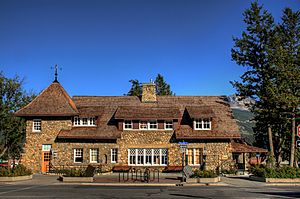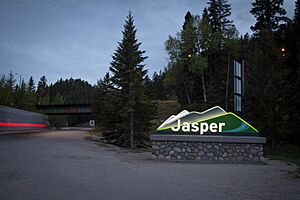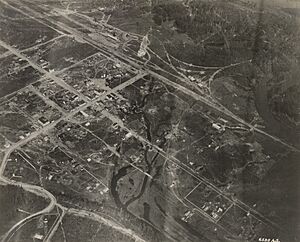Jasper, Alberta facts for kids
Quick facts for kids
Jasper
|
|
|---|---|
|
Specialized municipality
|
|
| Municipality of Jasper | |
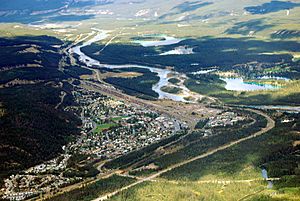
View of Jasper from the Jasper Tramway
|
|
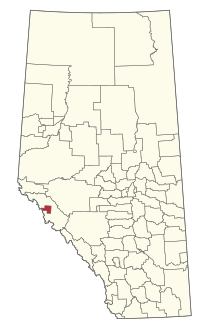
Location within Alberta
|
|
| Country | Canada |
| Province | Alberta |
| Region | Alberta's Rockies |
| Census division | 15 |
| Founded | 1813 |
| Incorporated - Improvement district |
August 31, 1995 |
| - Specialized municipality | July 20, 2001 |
| Area
(2021)
|
|
| • Land | 921.9 km2 (355.9 sq mi) |
| Elevation | 1,060 m (3,480 ft) |
| Population
(2021)
|
|
| • Total | 4,738 |
| • Density | 5.1/km2 (13/sq mi) |
| Time zone | UTC−7 (MST) |
| • Summer (DST) | UTC−6 (MDT) |
| Postal code span |
T0E
|
| Area code(s) | +1-780, +1-587 |
| Highways |
|
| Waterways | Athabasca River Miette River |
| Railways | Canadian National Railway |
Jasper is a special kind of town and area in western Alberta, Canada, located within the amazing Canadian Rockies. The town is nestled in the Athabasca River valley and is the main hub for Jasper National Park. It's a place where nature and adventure meet!
Contents
Jasper's Story: A Look Back in Time
Jasper started way back in 1813 as a place called Jasper House. It was a trading post for furs, first for the North West Company, then for the Hudson's Bay Company. This post was an important stop on a long trade route that went all the way to what is now British Columbia. The original Jasper House was about 35 kilometers (22 miles) north of where the town is today.
How Jasper National Park Began
In 1907, the area became Jasper Forest Park. A few years later, in 1911, a railway stop was built where the town is now. It was first called Fitzhugh. Another railway company started service in 1912. The town was officially mapped out in 1913 and renamed Jasper, after the old fur trade post.
In 1930, Jasper Forest Park got a new name: Jasper National Park. By 1931, you could drive to Jasper from Edmonton. Then, in 1940, the beautiful Icefields Parkway opened. This road connects Jasper to other famous places like Lake Louise and Banff.
Becoming a Municipality
Jasper became a "specialized municipality" in 2001. This means it's a unique type of local government that manages both the town and the surrounding rural areas within the national park.
Recent Events: The 2024 Wildfire
On July 22, 2024, a large wildfire started in Jasper. This fire caused significant damage to parts of the town.
Exploring Jasper's Geography
The Municipality of Jasper is in the western part of Alberta. It shares a border with British Columbia to the west. It is surrounded by Jasper National Park on its other sides. The Athabasca River, which starts from the huge Columbia Icefield, flows through Jasper. Other rivers like the Miette River and Maligne River also join the Athabasca here.
Jasper Townsite Location
The town of Jasper is about 362 kilometers (225 miles) west of Edmonton. It's also 290 kilometers (180 miles) north of Banff. You'll find it where Highway 16 (the Yellowhead Highway) and Highway 93 (the Icefields Parkway) meet. The town is surrounded by impressive mountains like Pyramid Mountain. Nearby lakes include Pyramid Lake, Patricia Lake, and Maligne Lake.
Nearby Areas in Jasper
Several smaller areas are located within the Municipality of Jasper. These include places like Bedson, Decoigne, Geikie, and Miette Hot Springs.
Jasper's Climate: Weather Patterns
Jasper has a climate that is a mix of humid continental and subarctic. This means it has warm summers and cold, snowy winters.
The highest temperature ever recorded in Jasper was 41.2°C (106.2°F) on June 30, 2021. The coldest temperature was a chilly -47.2°C (-53.0°F) on January 24, 1916.
Summers are usually pleasant, with daytime temperatures around 21°C (70°F). Nights are cooler, around 7°C (45°F). Winters are cold, with daytime temperatures around -2°C (28°F) and nighttime lows around -12°C (11°F).
| Climate data for Jasper, 1981−2010 normals, extremes 1914−present | |||||||||||||
|---|---|---|---|---|---|---|---|---|---|---|---|---|---|
| Month | Jan | Feb | Mar | Apr | May | Jun | Jul | Aug | Sep | Oct | Nov | Dec | Year |
| Record high °C (°F) | 13.3 (55.9) |
16.5 (61.7) |
20.8 (69.4) |
26.5 (79.7) |
30.4 (86.7) |
41.2 (106.2) |
39.4 (102.9) |
35.0 (95.0) |
33.7 (92.7) |
27.2 (81.0) |
18.0 (64.4) |
15.0 (59.0) |
41.2 (106.2) |
| Mean daily maximum °C (°F) | −3.3 (26.1) |
−0.4 (31.3) |
5.7 (42.3) |
10.9 (51.6) |
16.1 (61.0) |
19.6 (67.3) |
21.9 (71.4) |
21.7 (71.1) |
16.7 (62.1) |
10.0 (50.0) |
0.4 (32.7) |
−4.7 (23.5) |
9.6 (49.3) |
| Daily mean °C (°F) | −8 (18) |
−5.8 (21.6) |
−0.4 (31.3) |
4.5 (40.1) |
9.4 (48.9) |
13.1 (55.6) |
15.2 (59.4) |
14.6 (58.3) |
10.0 (50.0) |
4.4 (39.9) |
−4 (25) |
−9.1 (15.6) |
3.6 (38.5) |
| Mean daily minimum °C (°F) | −12.7 (9.1) |
−11.2 (11.8) |
−6.5 (20.3) |
−2 (28) |
2.6 (36.7) |
6.6 (43.9) |
8.4 (47.1) |
7.4 (45.3) |
3.2 (37.8) |
−1.3 (29.7) |
−8.3 (17.1) |
−13.5 (7.7) |
−2.3 (27.9) |
| Record low °C (°F) | −47.2 (−53.0) |
−43.3 (−45.9) |
−36.7 (−34.1) |
−28.9 (−20.0) |
−17.8 (0.0) |
−6.7 (19.9) |
−3.4 (25.9) |
−3 (27) |
−12.2 (10.0) |
−28.7 (−19.7) |
−38.8 (−37.8) |
−43.9 (−47.0) |
−47.2 (−53.0) |
| Average precipitation mm (inches) | 23.4 (0.92) |
14.3 (0.56) |
16.8 (0.66) |
19.7 (0.78) |
31.1 (1.22) |
51.0 (2.01) |
63.8 (2.51) |
64.5 (2.54) |
33.7 (1.33) |
30.5 (1.20) |
24.4 (0.96) |
19.5 (0.77) |
392.6 (15.46) |
| Average rainfall mm (inches) | 6.1 (0.24) |
3.8 (0.15) |
6.2 (0.24) |
13.2 (0.52) |
30.4 (1.20) |
50.4 (1.98) |
63.8 (2.51) |
64.6 (2.54) |
32.2 (1.27) |
23.1 (0.91) |
9.4 (0.37) |
2.2 (0.09) |
305.2 (12.02) |
| Average snowfall cm (inches) | 23.9 (9.4) |
14.7 (5.8) |
15.0 (5.9) |
8.1 (3.2) |
0.75 (0.30) |
0.57 (0.22) |
0.0 (0.0) |
0.0 (0.0) |
2.5 (1.0) |
9.3 (3.7) |
20.8 (8.2) |
24.4 (9.6) |
120.0 (47.2) |
| Average precipitation days (≥ 0.2 mm) | 10.6 | 7.9 | 8.1 | 8.9 | 11.1 | 13.9 | 14.1 | 14.7 | 10.5 | 9.8 | 10.4 | 9.6 | 129.6 |
| Average rainy days (≥ 0.2 mm) | 1.7 | 1.5 | 2.6 | 6.0 | 10.9 | 13.9 | 14.1 | 14.7 | 10.0 | 7.7 | 2.9 | 0.8 | 86.9 |
| Average snowy days (≥ 0.2 cm) | 9.9 | 7.1 | 6.8 | 4.1 | 0.73 | 0.07 | 0.0 | 0.0 | 0.60 | 2.7 | 8.4 | 9.5 | 49.9 |
| Mean monthly sunshine hours | 71.7 | 98.4 | 164.4 | 199.6 | 227.1 | 226.1 | 251.5 | 237.3 | 177.2 | 131.0 | 71.8 | 56.5 | 1,912.5 |
| Percent possible sunshine | 28.2 | 35.5 | 44.8 | 47.8 | 46.4 | 44.8 | 49.6 | 51.9 | 46.4 | 39.7 | 27.4 | 23.7 | 40.5 |
| Source: Environment Canada | |||||||||||||
Jasper's Population: Who Lives Here?
|
||||||||||||||||||||||||||||||
In 2021, the Municipality of Jasper had a population of 4,738 people. This number was a bit higher than in 2016, showing that more people are choosing to live in this beautiful area. The population density was about 5.1 people per square kilometer.
In 2011, a local count showed that Jasper had 5,236 residents. This included 4,584 people who lived there permanently and 652 who were non-permanent residents, like seasonal workers.
Fun Things to Do in Jasper
Jasper has many exciting places to visit! The Fairmont Jasper Park Lodge is a famous hotel nearby. For winter sports, there's the Marmot Basin ski resort. You can also take the Jasper Skytram up to the top of The Whistlers mountain for amazing views.
In the town itself, you can visit the historic Jasper Visitor Centre. There's also the beautiful St. Mary & St. George Anglican Church and the Jasper-Yellowhead Museum and Archives, where you can learn about the area's past.
Getting Around Jasper: Transportation
Jasper has a railway station that is served by Via Rail. You can take The Canadian train or the Jasper–Prince Rupert train to get here. Both trains run a few times a week.
There's also a small airport called Jasper Airport located north of the town. If you're driving, the Old Fort Point Bridge helps vehicles cross the Athabasca River just south of Jasper.
Learning in Jasper: Education
Students in Jasper can attend schools run by the Grande Yellowhead Public School Division No. 77. These include Jasper Elementary School for younger kids (Kindergarten to Grade 6) and Jasper Junior Senior High School for older students (Grades 7 to 12). Both schools offer English and French Immersion programs. There's also a French-speaking school called École Desrochers for students from kindergarten to Grade 12.
Jasper in the News: Media
Jasper has its own local newspapers, like the Jasper Fitzhugh and The Local. You can also listen to several radio stations in the area.
International Connections: Sister City
Jasper has a special connection with Hakone, Kanagawa, a town in Japan. They have been sister cities since 1972, which means they share cultural ties and friendly relations.
Famous People from Jasper
Many interesting people have come from Jasper, including:
- Ian Herbers, an NHL hockey player.
- John Hilworth, another NHL hockey player.
- Erin Karpluk, an actress known for the TV show Being Erica.
- Loni Klettl, an Olympic Alpine skier.
- Wyatt Tremblay, an editorial cartoonist.
- Kirby Morrow (1973–2020), a voice actor famous for roles like Miroku from Inuyasha and Cole from Ninjago.
- Brian Young, an NHL hockey player.
See also
 In Spanish: Jasper (Alberta) para niños
In Spanish: Jasper (Alberta) para niños


